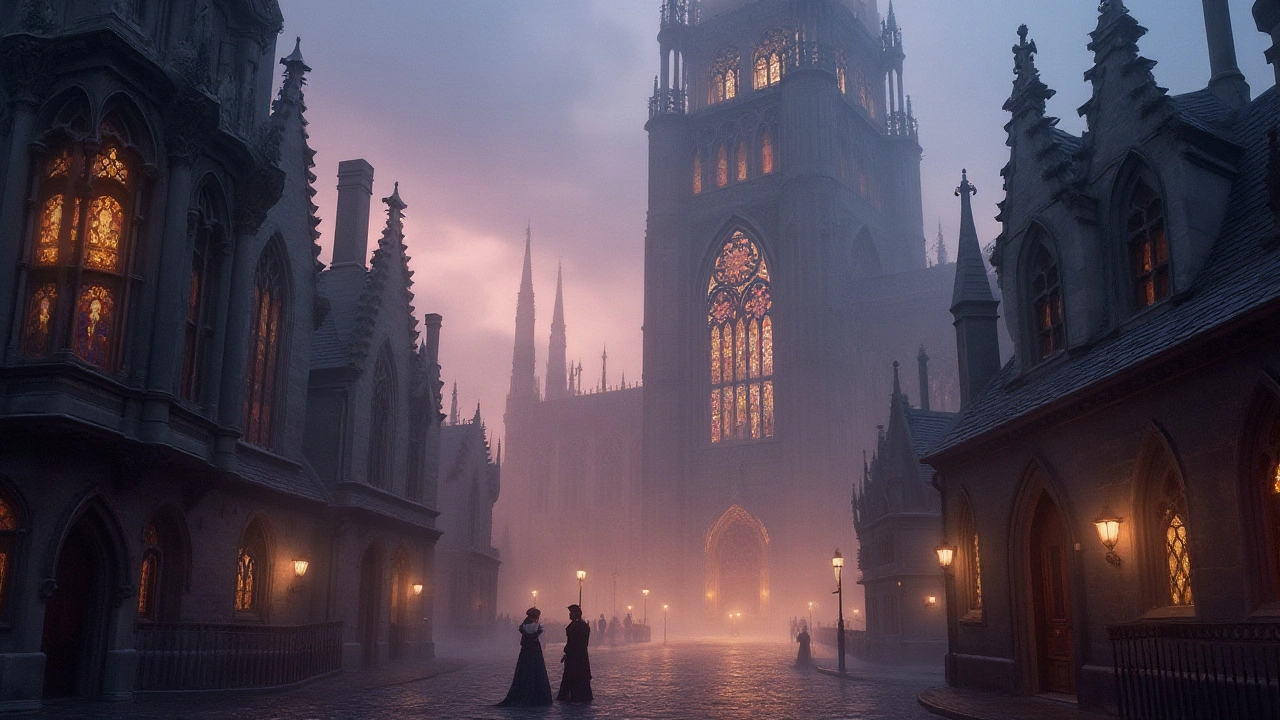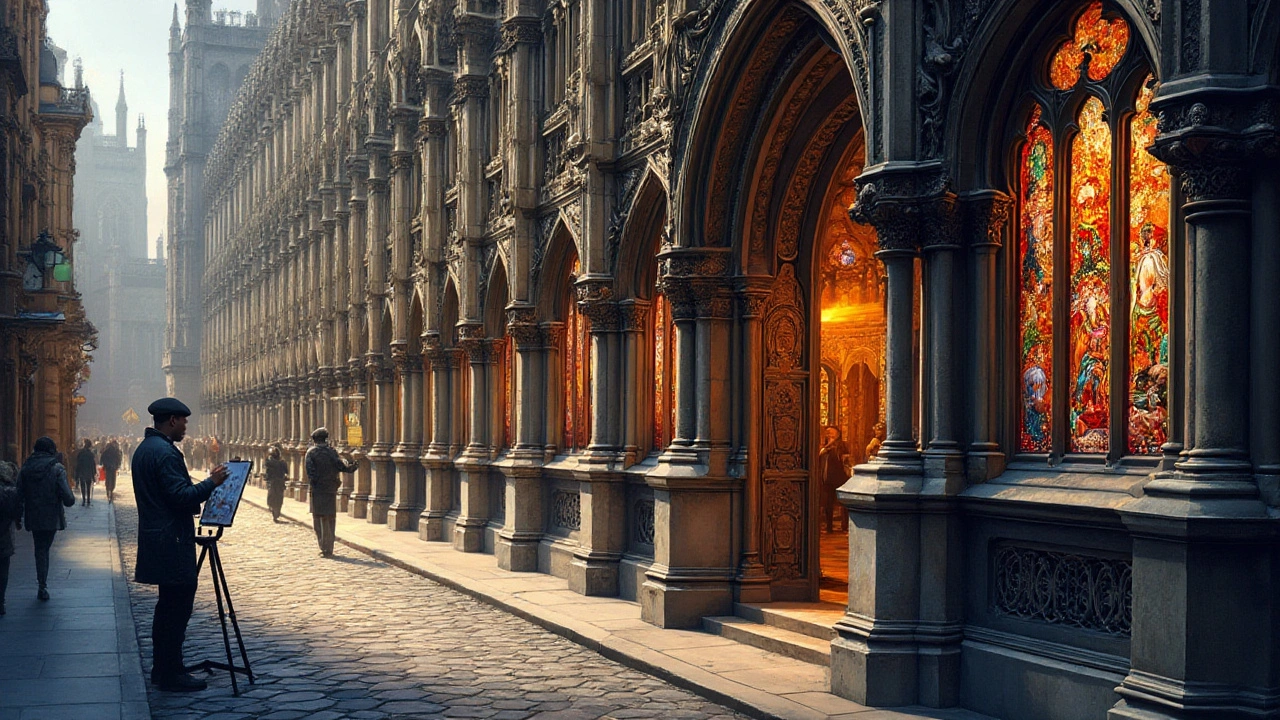Unveiling the Dark Allure of Gothic Architecture
 Feb, 1 2025
Feb, 1 2025
Step into the shadowy, breathtaking world of Gothic architecture—a style that stirs imaginations with its haunting beauty and intricate details. Born in the heart of medieval Europe, this architectural marvel has engraved its dark romance onto the edifices of grand cathedrals, churches, and castles. Its enchanting allure lies in the formidable towers that reach towards the heavens, captured in tales of ethereal beauty and a seemingly outlandish blend of art and engineering.
This mysterious architecture, often misunderstood due to the connotations of its name, embraces light through ornately crafted stained glass windows and draws the eye upwards with its characteristic pointed arches and ribbed vaults. Gothic architecture calls to those who wander its ancient halls, whispering stories of centuries past, where each carved stone bears witness to the grandeur of an era long gone.
Origins and Evolution
The story of Gothic architecture starts in the fertile lands of 12th-century France, a time when the creative spirit sought new forms of expression beyond the confines of Romanesque conventions. It was at the Basilica of Saint-Denis, under the direction of Abbot Suger, where the first glimmers of this revolutionary style began to unfold. Suger envisioned a space that celebrated divine light, which he believed was a reflection of God's presence. To achieve this, the architects of the time embraced new structural techniques that would allow for larger windows, resulting in the radiant stained glass features we admire today.
With pointed arches, ribbed vaults, and flying buttresses, Gothic architecture didn't merely capture attention but inspired awe. These elements weren't just for show—they were innovations that enabled builders to reach unprecedented heights and create interiors drenched in light. Spanning across the French borders, this architectural renaissance soon swept over Europe, influencing the skylines from England to Germany. It signified a move towards verticality and complexity that was both an engineering feat and a visual masterpiece.
During the late medieval period, the Gothic style saw further transformation and diversity. The High Gothic phase accentuated the original elements, pushing the boundaries of height and skeletal forms, epitomized by the towering facade of the Chartres Cathedral. As architectural techniques advanced, the Flamboyant Gothic style emerged, with its curvilinear patterns and flamboyant traceries adding an additional layer of decorative splendor. The style's reach touched Italy, though it was often met with amalgamations in the southern regions where Renaissance ideals were beginning to take root.
"In architecture, the beauty of structure serves dual purposes: aesthetic pleasure and the functionality that communicates the genius of design." - Viollet-le-DucThe expansion of commerce and the increased power of religious institutions spurred this architectural evolution, each element meticulously crafted to symbolize the power and grandeur of its patrons. Whether in the thundering silence of Notre-Dame de Paris or the skeletal labyrinth of Westminster Abbey, Gothic architecture left an indelible mark on the medieval landscape.
The evolution of Gothic architecture wasn't just a reflection of artistic trends but also the shifting societal landscape. Cathedrals became community hubs, their grandiose designs reflecting the ambitions and piety of those who built them. This architectural style experienced its final flourish in the Perpendicular Gothic movement, which marks the zenith of the style’s complexity and verticality, most notably witnessed in England.
Key Characteristics
The essence of Gothic architecture lies within its distinct and dramatic features which can send curious explorers on a voyage back to the medieval era. When one first gazes upon a Gothic cathedral, several elements leap out, daring you to look further. The hallmark of these structures is their verticality, achieved through the use of pointed arches. These arches were an engineering breakthrough, more structurally sound than their rounded predecessors while also elevating the interior spaces to dizzying heights. This feature allowed the buildings to be taller without sacrificing stability, bringing a new dimension to medieval architecture that was previously unattainable.
The importance of light cannot be understated in Gothic design. Stained glass windows, with their vibrant colors and detailed biblical narratives, transformed sunlight into divine walls of light, creating ethereal atmospheres inside these towering structures. This innovation was more than just artistic expression; it served to visually educate the largely illiterate population of the time. As the sunlight streamed through these windows, it painted scenes of religious significance and everyday medieval life, teaching and inspiring awe in equal measure. It’s a captivating element that remains influential today, not just for its beauty but its ingenious use of functional aesthetics.
Another vital characteristic is the flying buttress, an external architectural support, which allowed builders to push walls ever higher and incorporate larger windows without the fear of collapse. This technique is quintessential to Gothic architecture and can be seen explicitly in masterpieces such as the Notre-Dame de Paris. This groundbreaking design triumph allowed the internal walls to become more slender and drenched in light, bringing a celestial quality to the vast, echoing chambers within.
"The Gothic cathedral is like a luminous image of God in stone," remarked the renowned art critic John Ruskin, marveling at how these architectural giants manage to balance an otherworldly beauty with sobering strength.
Adorning these medieval designs are intricate sculptures, grotesques, and gargoyles, carved with a level of detail that reflects the human fascination with the metaphysical world. These decorations not only served artistic purposes but also worked as rain-spouts for runoff, their exaggerated features cleverly masking an ingenious practicality. The vaulted ceilings, yet another mesmerizing characteristic, drew eyes heavenward, encouraging contemplation and evoking a sense of divine inspiration.
Each of these key elements combined to create a sense of unity within chaos—the perfect fusion of form and function. It's no surprise that though centuries have passed since their conception, the motifs and architectural innovations of the Gothic style continue to be celebrated and adapted, inspiring generations of architects and artists. The interplay of light, height, and intricate artistry deftly inscribed Gothic architecture into the annals of history, a dark romance that continues to enchant those fortunate enough to walk its stone-clad corridors.

Notable Examples
When it comes to Gothic architecture, few structures capture the imagination as vividly as the cathedrals of Europe. One of the most iconic examples is the Notre-Dame de Paris, whose majestic façade and flying buttresses have stood the test of time since the 12th century. This emblematic edifice showcases the quintessential elements of the medieval design, with its twin towers and rose window that have drawn visitors from around the world. The cathedral's intricate sculptures tell stories of biblical scenes, a hallmark of Gothic artistry that aims to educate and inspire the faithful.
Traveling east to the city of Prague, the St. Vitus Cathedral stands as a testament to the enduring impact of the Gothic style. This stunning masterpiece, nestled within the Prague Castle complex, features a fascinating blend of Gothic and later architectural influences. Its soaring spires and stunning stained glass windows gleam in vibrant hues, offering a mystical experience for those who wander beneath its vaulted arches. Notably, the cathedral's Great South Tower houses a massive bell named Zikmund, which remains a marvel of medieval engineering.
In England, the Salisbury Cathedral captivates with an air of serene elegance. Completed in the mid-13th century, it boasts the tallest church spire in the United Kingdom, standing at a staggering 404 feet. The cathedral's cloisters and chapter house are remarkable for their beauty and historical significance. Here, the famous Magna Carta, a cornerstone of legal history, once found shelter. As architectural critic James Stevens Curl opined, "The beauty of Salisbury is that it embodies everything that is sublime in Gothic architecture."
Salisbury Cathedral's spire is not just awe-inspiring to behold, but a marvel of human ingenuity and craftsmanship, standing resolute against the tests of time."
Across the sea in Spain, the Cathedral of Santa Maria of Palma, affectionately known as La Seu, resides in the heart of Palma de Mallorca. This masterpiece is distinguished by its lavish interior and prominently features the work of Antón Gaudí, who played a role in its restoration in the early 20th century. Visitors find themselves drawn to its exquisite stained glass windows, which bathe the cathedral's ornate altarpieces in a kaleidoscope of colored light, creating a divine atmosphere that leaves a lasting impression.
Beyond cathedrals, the architectural style of Gothic extends to other impressive structures, like castles and civic buildings. The stunning Caernarfon Castle in Wales stands as a reminder of the architectural prowess of the era, with its commanding presence and defensive innovations. Neuschwanstein Castle in Germany, although constructed in the 19th century, borrows heavily from Gothic aesthetics, with its fairy-tale turrets and intricate stonework, captivating visitors and serving as an inspiration for fictional castles in popular culture.
These notable examples of Gothic architecture continue to enchant scholars, architects, and travelers alike, inviting them to step back in time and ponder the ingenuity and artistry that shaped these monumental creations. The legacy of Gothic architecture is an enduring story, a bridge connecting the visions of the past with the imaginations of the present, drawing all who experience it into its enchanting embrace.
Modern Impact
In today's bustling world, the influence of Gothic architecture resonates in remarkable and unexpected ways. From inspiring architects to influencing pop culture, the elements of this architectural style have woven their way into the fabric of modern creative expressions. Its signature Gothic features like pointed arches, flying buttresses, and ribbed vaulting have captured the imagination of contemporary architects seeking to blend historical charm with modern aesthetics. These elements evoke a sense of nostalgia and romance, inviting us to explore unconventional approaches in artistic design.
In architecture, the revival of Gothic elements can be witnessed in many contemporary structures. For instance, the Washington National Cathedral in the United States showcases elaborate stonework and stunning stained glass windows, echoing the historical grandeur of the Middle Ages. This fusion of classic and modern styles helps maintain the mystical aura that Gothic architecture originally imparted, blending both past and present. It shows that this medieval design remains a source of inspiration, seamlessly integrating with our desire for grandeur and beauty.
Besides architecture, Gothic influences have stretched into the realms of entertainment and fashion. The film industry often uses Gothic cathedrals as backdrops for movies and television shows, enhancing the dramatic and mysterious ambiance of their narratives. The fashion world embraces Gothic motifs in fashion collections, with designers often playing with dark, elaborate, and romantic themes, enkindling the same dramatic allure on the runway as in the medieval past.
"The Gothic revival is not just about aesthetics; it's about tapping into a deeper emotion, a longing for something beyond the ordinary," noted renowned architect and historian Dr. Emily Larson.
Educational institutions also incorporate this architectural style, using its evocative design elements to create environments that inspire learning and creativity. Universities such as Yale and Princeton employ Gothic architecture to lend a sense of prestige and tradition to their campuses, reminding students and visitors alike of the timeless connection between knowledge and historical legacy.
The modern appeal of Gothic architecture is further accentuated by its adaptability. Technological advancements in construction allow architects to explore innovative designs that echo the past yet accommodate the present. Materials like glass, steel, and reinforced concrete enable the recreation of Gothic motifs in a sustainable and eco-friendly manner. The use of these materials in recent projects emphasizes the adaptability and enduring power of Gothic architectural principles.
The impact of Gothic architecture's aesthetic and philosophical foundations remains undeniable. Its mysterious charm continues to captivate and inspire new generations, ensuring that its legacy is not just preserved but celebrated in fresh and exciting ways. By embracing the tenants of this style, we ensure that the spirit of medieval creativity remains a vibrant part of the building blocks for future innovations.